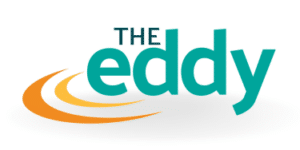
As your outfit grows, so will your need to fill mid-level supervisory positions.
Here at Zebulon, we believe incorporating leadership-oriented supervisor positions into your outfit with intentionality will give you a true competitive edge. However, if you fill supervisor positions without intentionality (or worse – if you don’t incorporate them at all), your outfit may suffer and stagnate.
By intentionally incorporating supervisor roles into your outfit’s depth chart, you can avoid both a high turnover and a lack of vision, all while unlocking the enviable ability for information to flow upward in your outfit.
Outfits that don’t build leadership-oriented supervisory roles into their depth charts tend to experience an unfortunate reality. On the one hand, these outfits experience a high employee turnover rate. And on the other hand, workers in these outfits don’t see a long-term future for themselves at their company or even the broader industry.
For a quick summary of supervisor roles, check out our Supervisor Worksheet here. Otherwise, keep reading for a more in-depth understanding of the role.
The Traditional Corporate Hierarchy Pyramid
Most people are familiar with traditional corporate hierarchy. The C-Suite and company executives sit atop the pyramid, Senior Managers fill the next tier down, Junior Managers sit below them, and regular ole’ employees form the pyramid base.
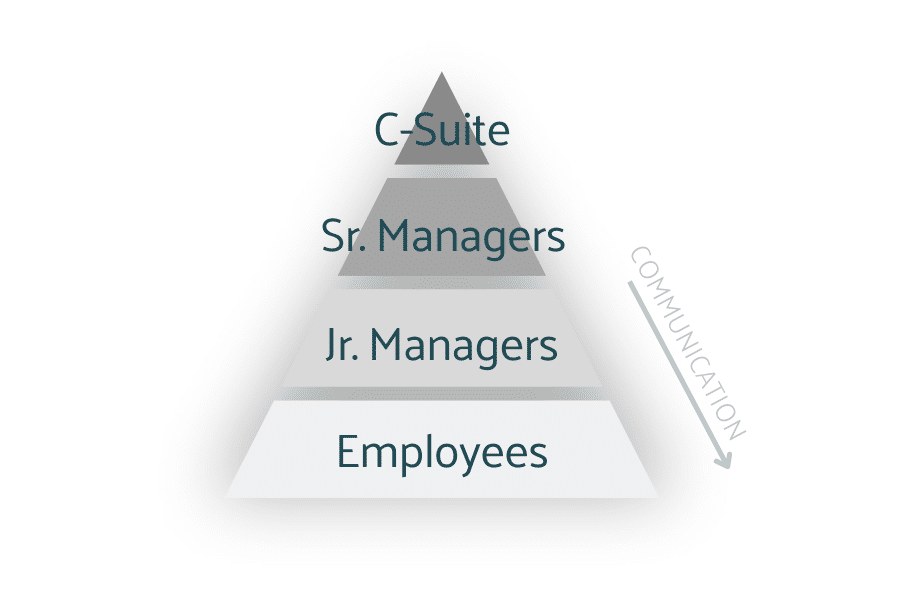 In traditional corporate hierarchy (and, coincidentally, in most outfit hierarchies), communication and information trickles down from above. Ever heard of the phrase “shit rolls down hill”? This means decisions flow down from the top, regardless of the impact they may have, positive or negative, on the worker tiers below.
In traditional corporate hierarchy (and, coincidentally, in most outfit hierarchies), communication and information trickles down from above. Ever heard of the phrase “shit rolls down hill”? This means decisions flow down from the top, regardless of the impact they may have, positive or negative, on the worker tiers below.
Typically, outfit owners model their hierarchies after the typical corporate pyramid. Yet, outfit owners and senior managers also typically assume junior-management-type responsibilities, such as handling task completion duties and scheduling. This leaves a void in many crucial management functions, which serve to work on the business. These crucial functions include vision-casting, leadership development, and instilling a sense of ownership among team members.
Today’s Shift in Outfitting Dynamics
Outfitting is currently experiencing some massive shifts in power dynamics. As over 100+ outfit owners & CEOs discussed at the December ‘23 America Outdoors conference, one of the industry’s biggest underlying currents relates to the younger workforce. This includes difficulties finding reliable workers, communicating effectively with them, and retaining them for more than one season – or sometimes, even just retaining them for one full season.
Interestingly enough, according to employment and research agency Randstad, today’s workers want “secure, flexible, inclusive, and financially stable employment in a place they feel they belong.”
So … Who’s in the wrong here? Or do we simply have different workplace values?
Outfitting’s “Black Hole” of Supervisors
Many outfits are also experiencing a huge generational shift. Outfit owners and founders, the “OG” visionaries responsible for building this industry from the ground up, are transitioning away from running their businesses. Their hand-picked successors are starting to shoulder more top-level responsibilities, move upward into true leadership positions, and call the shots.
Given the nature of outfitting, day-to-day operations still require a solid foundation of entry-level team members (which tend to be seasonal). These roles consist of guides, administrative workers, drivers, and more.
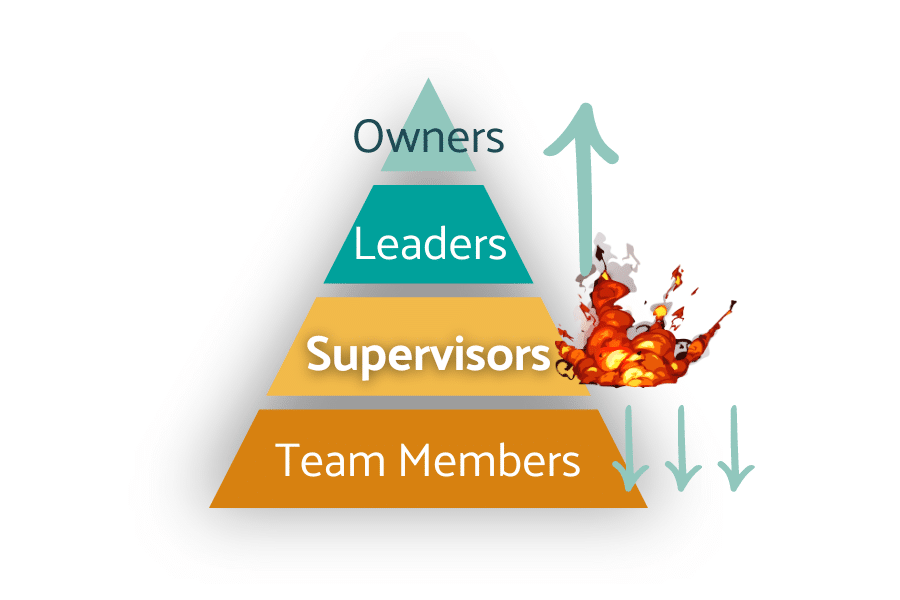
So, as owners transition toward retirement, top leaders are stepping up to fill their shoes, which creates upward movement at the top of the pyramid. Meanwhile, a consistent seasonal workforce of junior team members is needed to hold down the fort for daily operations, meaning a downward force at the base of the outfitting pyramid.
As a result, in the middle of the pyramid where mid-level leadership positions, or “Supervisors,” should be supporting both leaders above and team members below, these opposing migrations instead leave a gaping hole.
A Closer Look at Leadership-Oriented Supervisors
So, what exactly is the role of the supervisor? You’ve heard the term before, but probably used it interchangeably with “manager.” We’re here to change that with a little intentional leadership.
If you’re familiar with the 6 Working Geniuses model of team building, Supervisors should fill the “galvanizing” and “enabling” roles on a team. This means they should rally the troops behind the company, provide encouragement and assistance for ideas and projects, and keep a low- to mid-level perspective on their outfit.
For example, a CEO should maintain an elevated 30,000-foot-view of the bigger picture and goals, and entry-level team members should be ground-level task machines. Thus, supervisors should form the “close-enough-to-the-action” 10-to-15-thousand-foot perspective.
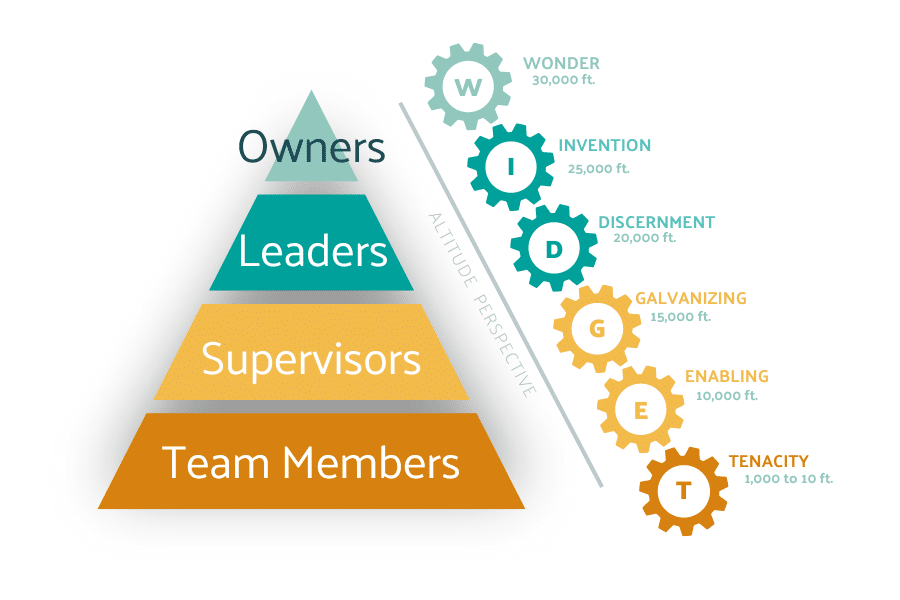
Think back to the traditional corporate hierarchy from before (the gray-scale pyramid above): here, the third-tier Junior Manager roles tend to be task-focused and objective-oriented. In contrast, in our outfitting Leadership Pyramid, Supervisors should take an ownership-oriented and growth-focused approach to their duties.
Supervisors: The Right Stuff
Supervisors should be your “cream of the crop” employees. They should demonstrate both leadership potential and loyalty to your outfit, all while supporting your outfit’s vision. They’re the employees you most want to retain and replicate in character, dedication, and determination.
It’s best if a supervisor has at least one year’s tenure with your outfit, maintains strong relationships with your leaders, and is beloved by your broader employee base. Perhaps surprisingly, supervisors should be close to the level of the teams they supervise, or even at their supervisees’ same level. Given their similarity in stature, a supervisor’s direct reports are more likely to relate to and trust them (much more so than they would with far-removed “old guys” managers and owners).
In function, outfit supervisors should be responsible for the personal and professional development of 2 to 5 team members. One huge competitive edge: assuming the role of supervisor is an excellent way for non-veteran employees to dip their toes into the world of leadership.
With proper implementation, and with consistent communication with their assigned team members, supervisors ensure information and communication flow upward toward the top of the leadership pyramid. As such, by consistently checking in with their small cohort of “supervisees” and reporting back to their own leaders, supervisors serve as the conduit of information between team members and upper leadership.
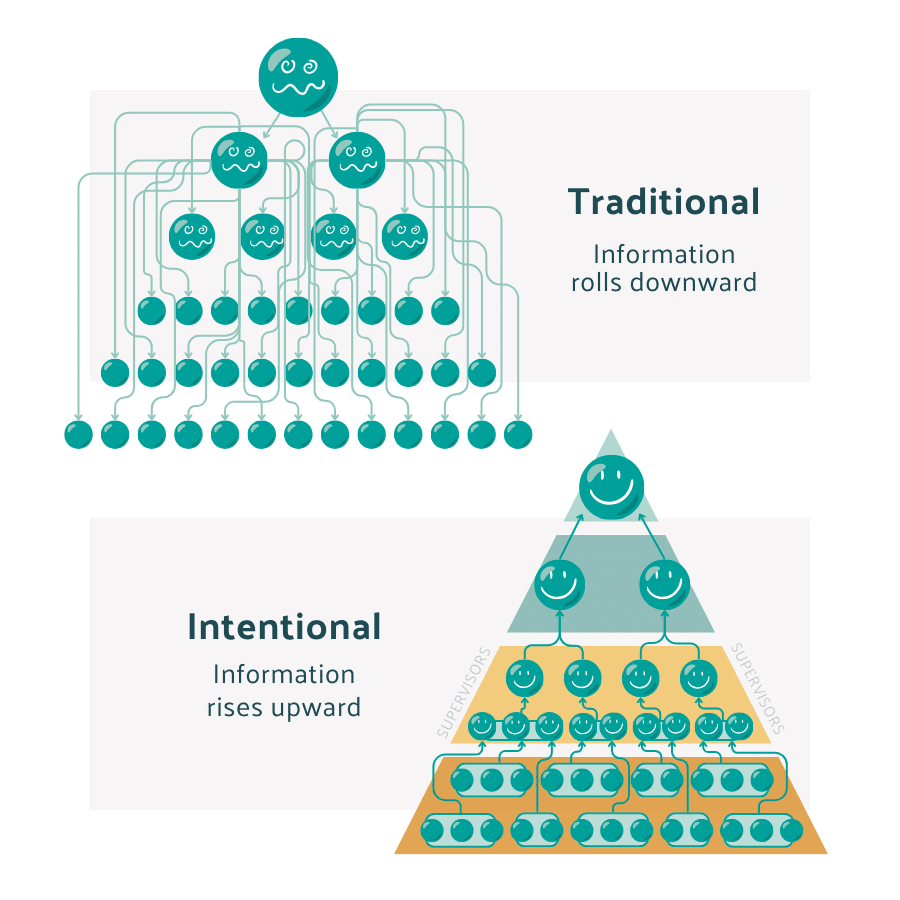
The Cream Rises to the Top
So, how do you determine which of your team members are your “cream of the crop” candidates for supervisor roles?
Our favorite method is doing an Employee Grading exercise, where you grade all employees (confidentially, of course), on certain factors like technical skills, workforce ethics, workplace attitudes, customer satisfaction, communication skills, and more. After tallying all scores, you’ll have a quantifiable and objective ranking of all team members. From here, it’ll be clear exactly which shining stars are at the top of your list – and we recommend picking supervisors from your top 10-20%. More on this in upcoming articles later.
Another frequent question we get is, “Won’t my Supervisors want extra compensation?” And our answer is: not necessarily. By practicing clear communication yourself, you should explain how assuming leadership-oriented supervisor roles is just one step in employees’ professional growth trajectories. By folding supervisor duties into job descriptions and setting proper expectations at the beginning of each season, your workforce will understand that performing well in supervisor roles will set them up for future leadership positions (and higher compensation tiers to match) in the future.
Additionally, we’re big fans of creating bonus and incentive programs that are performance-based. You may decide to incentivize your supervisors with performance-based bonuses at the end of the season, depending on the business’s profitability, the effectiveness of their communication skills, and the ways they’ve helped develop the professional skills of their cohorts.
Crawl, Walk, & Run: Zebulon’s Recommended Methods to Set Up Supervisors For Success
Here are three tried-and-true methods for developing your outfit’s own Supervisor roles and improving upward communication channels.
Crawl: Harness the Power of Mentorship
One of the simplest ways to establish supervisor roles in your outfit is by implementing a mentorship program. Whether you do it formally or informally, mentorship is a great method for seasonal workers.
There are numerous ways to begin a mentorship cycle, so we recommend referencing this Forbes article on how to nurture effective mentorships. In essence, you’ll want to first identify your mentors and who they’ll be mentoring, then define objectives and establish some structure around the mentorship cycle, and finally, measure the success and outcomes over a period of time – say, during a full operating season.
Walk: Gallup’s Q12 Questionnaire
For a more in-depth approach to mentoring, we recommend implementing Gallup’s Q12 questionnaire in your outfit. The Q12 has been around for decades, and is consistently heralded as an effective way to measure both employee satisfaction and engagement.
Each of Gallup’s twelve questions pinpoints a distinct need that managers and supervisors can meet to improve team members’ productivity and engagement. Responses to this questionnaire tend to highlight the areas of a company that struggle with employee satisfaction. And, satisfaction ties directly to employee retention, which is one of the primary workforce concerns outfit owners experience.
In particular, we recommend paying special attention to the following questions:
- Question #4: “In the last seven days, I have received recognition or praise for doing good work”
- Question #5: “My supervisor, or someone at work, seems to care about me as a person”
- Question #6: “There is someone at work who encourages my development”
- Question #7: “At work, my opinions seem to count”
- Question #11: “In the last six months, someone at work has talked to me about my progress”
Run: Implementing Full-Scale Performance Reviews & Routines
For those looking to dive head-first into the deep end of supervisory success, we recommend establishing formal performance reviews, a-la the book First Break All the Rules.
If you’ve ever heard the phrase, “People leave managers, not companies,” you can thank FBATR author Markus Buckingham for that gem! And boy, is he right.
While performance management routines are unique to each supervisor handling them, here are four things the most successful routines have in common:
- Keep things simple – don’t make them too complex.
- Plan frequent interactions with your individual team members.
- Focus on the future – don’t dwell too much on past performance.
- Encourage individuals to track their own performance and learnings. This way, they’re actively involved in the process (and not just passively participating).
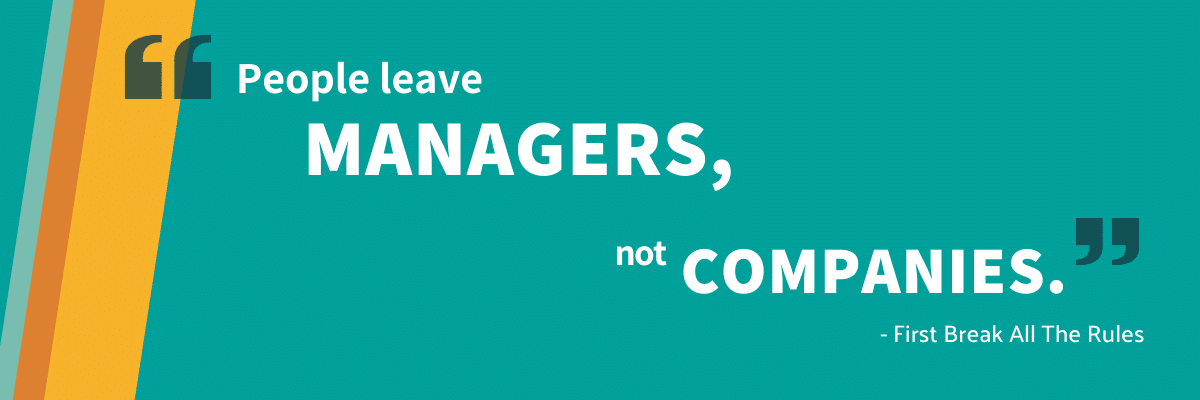
Don’t Just Take Our Word For It …
This article covers one of the core topics discussed in our Eddy group, a non-competitive peer group for growth-focused outfit owners and leaders. We spent an entire month discussing how Eddy members can beef-up supervisor roles in their own businesses. Collectively, the group served as a sounding board and accountability squad as members began implementing supervisor roles with intentionality.
So, we’ll leave you with a testimonial, straight from the mouth of one of our Eddy members:
“I formalized the supervisor and leader roles during this week’s team meeting. Very well received, and appreciated by the crew. I could see their eyes light up with the new promotions and immediately noticed a fresh approach and mindset, all a result of Zebulon’s new leadership pyramid. We’re going to compensate supervisors and leaders on the back end in the bonus pool. I greatly appreciate the recent Eddy group’s work on this!”
– Moses, Owner
For our summary of Supervisor Roles, don’t forget to check out our Supervisor Worksheet here.
If you own or lead an innovative and knowledge-hungry outfit, and would like to join our timely and relevant outfit accelerator, reach out to us here.



